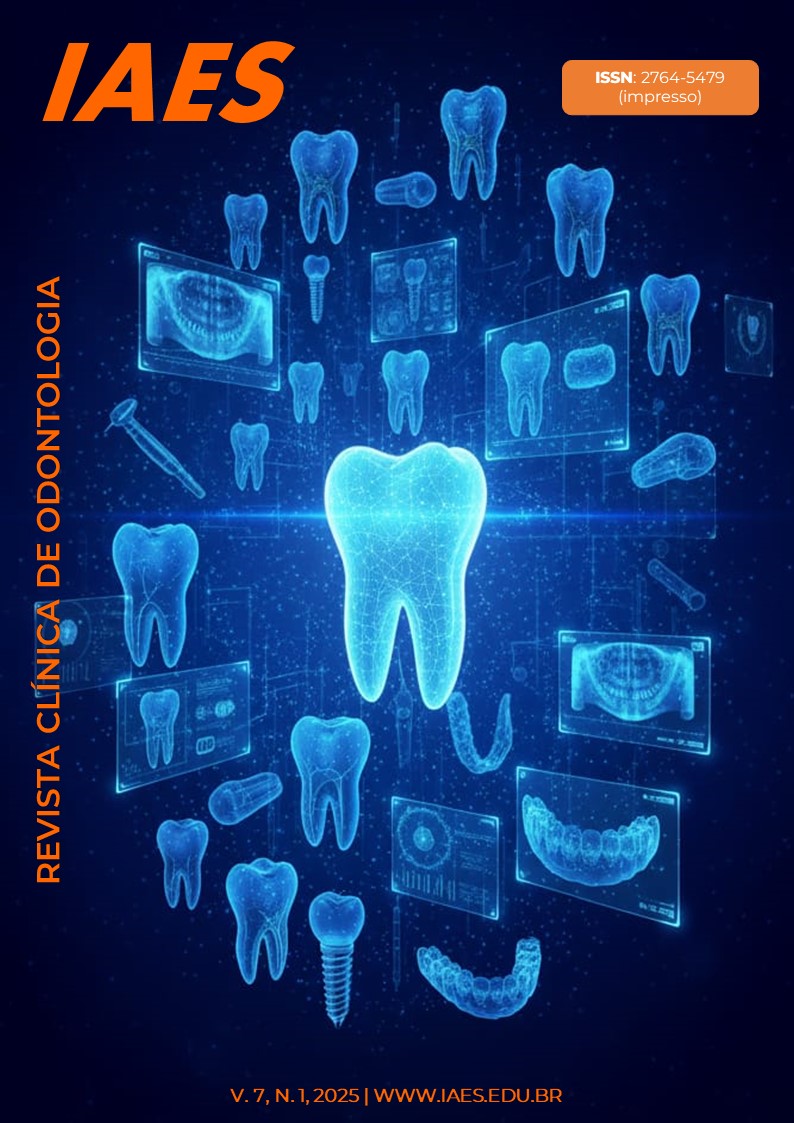Treatment of oroantral communication with ozone therapy: case report
DOI:
https://doi.org/10.70614/bc1dr151Keywords:
Ozone therapy, Oroantral communication, Maxillary sinus, Bone healing, Dental extraction complicationsAbstract
Ozone therapy is a bio-oxidative treatment based on the application of a medicinal gas mixture of oxygen and ozone. Among its therapeutic effects, it has been shown to improve metabolism and peripheral tissue oxygenation. Therefore, it is a non-invasive treatment modality and is also used to promote bone healing. Ozone naturally occurs in a gaseous form consisting of three oxygen atoms but can also be found in aqueous form. Ozone therapy can induce various effects in the human body, such as improved blood circulation and, consequently, enhanced oxygen delivery to tissues. This therapy also plays a role in increasing cellular antioxidant enzyme activity, growth factor levels, and immune system activation. Oroantral communication is a complication that can occur following the extraction of upper premolars and molars due to the proximity of the roots to the maxillary sinus. This communication allows access from the oral cavity to the sinus, altering the bacterial flora. In chronic cases, the orifice created between the mouth and sinus may undergo epithelialization, forming an oroantral fistula. Therefore, the present article aims to describe a case report on the treatment of an oroantral communication that occurred after the extraction of a third molar and a supernumerary tooth using ozone therapy.
Downloads
References
1. J. SINGH, S. P. BANSAL, M. D. DESHPANDE, N. K. SHARMA, AND R. S. Desai, “Osteonecrosis of the maxilla in a patient on ibandronate: A case report,” 2019. Eur. Geriatr. Med., vol. 4, no. 4, pp. 275–277.
2. P. C. MATHAI, N. N. ANDRADE, T. KOLUR, S. C. NAIR, AND B. Kumar, “Osteonecrosis of Maxilla Secondary to Bisphosphonate Therapy: A Case Report,” 2018. J. Maxillofac. Oral Surg., vol. 14, no. S1, pp. 52–56.
3. A. BAUR, D. A. BAUR, M. A. ALTAY, S. TEICH, M. B. A. MEGHAN, S. OSWALD, AND F. A. Quereshy, “SENSHIO y osteonecrosis mandibular La administración prolongada de bifosfonatos está asociada a un mayor riesgo de aparición de osteonecrosis maxilar, considerada como un efecto de clase de este grupo de fármacos. Igualmente, se han descritos casos de o,” 2017. vol. 46, no. 5, pp. 423–429.
4. P. MAURER, T. SANDULESCU, M. S. KRIWALSKY, A. RASHAD, S. HOLLSTEIN, I. STRICKER, F. HÖLZLE, AND M. Kunkel, “Bisphosphonate-related osteonecrosis of the maxilla and sinusitis maxillaris,” 2020. Int. J. Oral Maxillofac. Surg., vol. 40, no. 3, pp. 285–291.
5. G. MAST, S. OTTO, T. MÜCKE, C. SCHREYER, O. BISSINGER, A. KOLK, K. D. WOLFF, M. EHRENFELD, S. R. STÜRZENBAUM, AND C. PAUTKE, “Incidence of maxillary sinusitis and oro-antral fistulae in bisphosphonate-related osteonecrosis of the jaw,” 2019. J. Cranio-Maxillofacial Surg., vol. 40, no. 7, pp. 568–571.
6. R. E. LITTLE, C. M. LONG, T. A. LOEHRL, AND D. M. Poetker, “Odontogenic sinusitis: A review of the current literature,” 2018. Laryngoscope Investig. Otolaryngol., vol. 3, no. 2, pp. 110–114.
7. ABUABARA, A. L. V CORTEZ, L. A. PASSERI, M. DE MORAES, AND R. W. F. MOREIRA, “Evaluation of different treatments for oroantral/oronasal communications: Experience of 112 cases,” 2016. Int. J. Oral Maxillofac. Surg., vol. 35, no. 2, pp. 39 155–158.
8. S. H. VISSCHER, M. R. F. VAN ROON, W. J. SLUITER, B. VAN MINNEN, AND R. R. M. BOS, “Retrospective study on the treatment outcome of surgical closure of oroantral communications,” 2020. J. Oral Maxillofac. Surg., vol. 69, no. 12, pp. 2956–2961.
9. ENRICO BORGONOVO, “Surgical Options In Oroantral Fistula Treatment,” 2019. Open Dent. J., vol. 6, no. 1, pp. 94–98.
10. G. K. PARISE AND L. F. R. TASSARA, “Tratamento Cirúrgico e Medicamentoso das Comunicações Buco-Sinusais: Uma Revisão da Literatura,” 2016. Perspectiva, vol. 40, no. 149, pp. 153–162.
11. N. ZASLAVSKAYA, A. DROBYSHEV, A. VOLKOW, N. DIKOPOVA,T. SHIPKOVA, " Efficiency of ozone-therapy in the treatment of bisphosphonate-related osteonecrosis of the jaws in patients with malignant diseases." 21st ICOMS 2019—Abstracts: Oral Papers.
12. SUH Y, PATEL S, KAITLYN R, GANDHI J, JOSHI G, SMITH NL, KHAN SA. "Clinical utility of ozone therapy in dental and oral medicine." Med Gas Res 2019;9:163-167.
13. P. J. VOSS, D. STEYBE, P. POXLEITNER, R. SCHMELZEISEN, C. MUNZENMAYER, H. FUELLGRAF, A. STRICKER, AND W. SEMPERHOGG, “Osteonecrosis of the jaw in patients transitioning from bisphosphonates to denosumab treatment for osteoporosis,” Odontology. 2018. vol. 106, no. 4, pp. 469–480.
14. R. C. BOFF, F. G. SALUM, M. A. Figueiredo, and K. Cherubini, “Important aspects regarding the role of microorganisms in bisphosphonate-related osteonecrosis of the jaws,” Arch. Oral Biol. 2018. vol. 59, no. 8, pp. 790–799.
15. B.F.Z. SANTOS, M. D. MORAES, ''Avaliação de diferentes tratamentos para comunicações bucosinusal/buconasal: estudo retrospectivo.'' 2018.
16. L. ZHU, X. MIN, AND X. WANG, “Mechanism of fixation of ozone 40 and its medical value,” J. Wuhan Univ. Technol. Mater. Sci. 2019. Ed., vol. 29, no. 6, pp. 1183–1186.
17. MILNEROWICZ, HALINA, SLIWI ´ NSKA-MOSSO ´ N, MARIOLA, SOBIECH, ´ KRZYSZTOF A., The effect of ozone on the expression of metallothionein in tissues of rats chronically exposed to cadmium.Environmental Toxicology and Pharmacology. 2017.03.010. http://dx.doi.org/10.1016/j.etap.
18. BITTENCOURT KP, PEREIRA JC. Comunicação Buco Sinusal, Diagnóstico e Tratamento: uma revisão de literatura. Trabalho de conclusão de curso – Centro Universitário Tiradentes, Aracaju, 2017, 13.
19. CUNHA G, et al. Comunicação buco sinusal: do manejo clínico a abordagem cirúrgica. Revista de Odontologia da UNESP, 2017; 47(34): 0-0.
20. COELHO JV, TORRE SG. Desplazamiento por iatrogenia de tercer molar a seno maxilar: reporte de caso clínico. Revista de Administração em Saúde, 2018; 75(1): 39-44.
21. GUSMAN DJR, et al. Fechamento de Fístula bucoantral: relato de caso clínico. Revista Funec Científica, 2017; 1(35): 33-45.
22. NOGUEIRA EFC, et al. Uso de Retalho Palatino Combinado com bucal no tratamento de fístula bucosinusal recidivante: relato de caso. Odontologia Clínica Científica, 2018; 17(2): 25-30
Downloads
Published
Issue
Section
License
Copyright (c) 2025 Revista Clínica de Odontologia

This work is licensed under a Creative Commons Attribution 4.0 International License.






